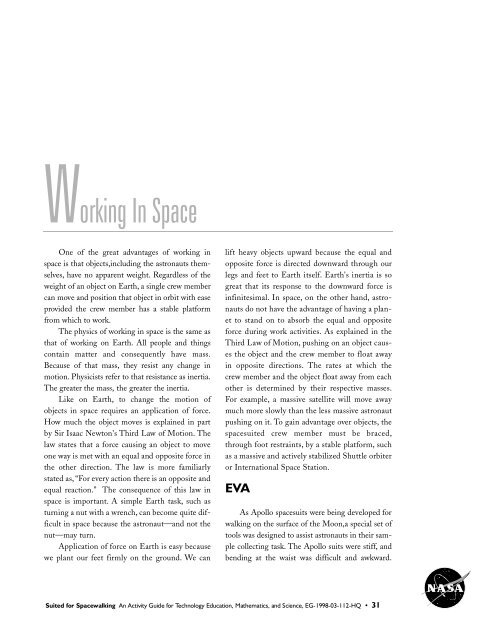Suited for Spacewalking pdf - Virtual Astronaut
Suited for Spacewalking pdf - Virtual Astronaut
Suited for Spacewalking pdf - Virtual Astronaut
- No tags were found...
You also want an ePaper? Increase the reach of your titles
YUMPU automatically turns print PDFs into web optimized ePapers that Google loves.
Working In SpaceOne of the great advantages of working inspace is that objects,including the astronauts themselves,have no apparent weight. Regardless of theweight of an object on Earth, a single crew membercan move and position that object in orbit with easeprovided the crew member has a stable plat<strong>for</strong>mfrom which to work.The physics of working in space is the same asthat of working on Earth. All people and thingsc ontain matter and con s e q u e n t ly have mass.Because of that mass, they resist any change inmotion. Physicists refer to that resistance as inertia.The greater the mass, the greater the inertia.Like on Eart h , to change the motion ofobjects in space re q u i res an applica t i on of <strong>for</strong>c e .H ow mu ch the object moves is explained in partby Sir Isaac Newt on's T h i rd Law of Motion . T h elaw states that a <strong>for</strong>ce causing an object to moveone way is met with an equal and opposite <strong>for</strong>ce inthe other dire c t i on . The law is more familiarlystated as, “For eve ry action there is an opposite andequal re a c t i on . ” The consequence of this law inspace is import a n t . A simple Earth task, s u ch ast u rning a nut with a wre n ch , can become quite difficultin space because the astronaut—and not then u t — m ay turn .Ap p l i ca t i on of <strong>for</strong>ce on Earth is easy beca u s ewe plant our feet firm ly on the gro u n d . We ca nl i ft heavy objects upw a rd because the equal andopposite <strong>for</strong>ce is directed dow nw a rd through ourlegs and feet to Earth itself. E a rth's inertia is sog reat that its re s p onse to the dow nw a rd <strong>for</strong>ce isi n f i n i t e s i m a l . In space, on the other hand, a s t ronautsdo not have the advantage of having a planetto stand on to absorb the equal and oppositef o rce during work activities. As explained in theT h i rd Law of Motion , pushing on an object ca u s-es the object and the crew member to float awayin opposite dire c t i on s . The rates at which thec rew member and the object float away from eachother is determined by their re s p e c t i ve masses.For example, a massive satellite will move awaymu ch more slow ly than the less massive astron a u tpushing on it. To gain advantage over objects, t h espacesuited crew member must be bra c e d ,t h rough foot re s t ra i n t s , by a stable plat<strong>for</strong>m , s u chas a massive and active ly stabilized Shuttle orb i t e ror Intern a t i onal Space St a t i on .EVAAs Apollo spacesuits were being developed <strong>for</strong>walking on the surface of the Moon,a special set oftools was designed to assist astronauts in their samplecollecting task. The Apollo suits were stiff, andbending at the waist was difficult and awkward.<strong>Suited</strong> <strong>for</strong> <strong>Spacewalking</strong> An Activity Guide <strong>for</strong> Technology Education, Mathematics, and Science, EG-1998-03-112-HQ • 3 1
















